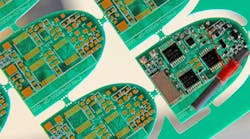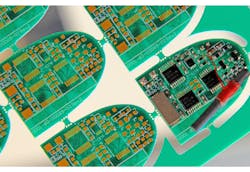What’s the Difference Between Reference and Custom Hardware Design?
This file type includes high-resolution graphics and schematics when applicable.
In advanced product development, electronics are not exactly a commodity. Those of us who have gone through it may go as far as saying that hardware design is the root of all evil—laborious, unforgiving, permanently obeying the laws of physics (which has been known to contradict the way you intended that last circuit to operate).
Make vs. buy has never been more nebulous. Here’s a definitive guide on when to take on those printed-circuit-board (PCB) spins, and when to pass.
Scenario # 1
You’re part of a startup, looking to launch the next great in-home Wi-Fi connected device. You have a killer app and backend infrastructure to complement it.
Unless your (realistic) projections call for more than one million users in year one, skip that daunting chip-down design that promises bill-of-materials (BOM) savings, and go straight for a module-based approach. It’s okay—you can still flex your layout muscles on a carrier board.
The mistake many make is overlooking regulatory certification testing. It may seem at first as if you’re splurging on certification testing for that nice little module, but think of a large percentage of that cost as insurance. It’s peace of mind for never having to deal with out-of-band emissions, or that seemingly random susceptibility of a receiver to selected frequencies. Not to mention that bizarre loss of 2 dBi in your antenna gain (simulation pays off, but that is topic for another article altogether).
Manufacturers such as Atmel/Microchip, Lantronix, or Silex provide you with solutions that avoid that potentially painful and time-consuming experience. The tradeoff is obviously a modest hit in cost to your BOM, but consider these two additional points (as if the aforementioned RF headaches weren’t enough):
1. Firmware: Writing code to directly control a radio is vastly more complicated than shipping your data to a small on-module microcontroller over an I2C or ) interface.
2. Flopping on your market entry: Delayed launches, or early shipments plagued with performance issues, guarantee only one thing—your user base not growing to expected levels. No need for further tech advice here.
Scenario # 2
You have chosen to swim upstream, and enter the wearables market. That same infinite wisdom has also guided you toward a Cortex-M0 microprocessor, a Bluetooth Low Energy (BLE) radio, 9-axis motion sensor, and an impossibly large amount of flash memory (now would be a great time to rerun those numbers). A small micromanaged battery rounds out your offering. Your research has also led you to believe that the only way to fit all of this into your physical application is to undergo a microelectronics project, consisting of purchasing bare die parts, and then performing a flip-chip/die-attach/wire-bond design.
Before roaming too far down this path, consider the following:
• Component availability: Don’t assume that all major components on your preliminary BOM are available in die form. Do your homework and inquire—the results may surprise you. Oftentimes, even when an IC is available, there is a 10,000 minimum piece buy for bare die.
• Time: Non-recurring engineering (NRE) will take time, without a doubt. Researching the right firm to get the job done can also be a drawn-out proposition. Keep in mind that design and manufacturing may not occur under one roof, forcing you to do additional research to completely map out your plan. Always be realistic about economic analysis units (EAUs) when having these discussions. Better to take rejection at this phase, than once you have booked orders.
• Return on investment: The cost of such an undertaking can add up quickly. At IPS, we come across these types of projects on a fairly regular basis. Typically, unless you are looking at upwards of 100,000 yearly units, this technique is simply cost-prohibitive. There are just not enough units over which to amortize the NRE.
Traditional design methods are usually best in these cases. Spend the time instead miniaturizing your layout. I always tell my clients that PCB size and project schedules are inversely proportional. So go ahead and fire up that Altium license! Better yet, leverage a reference design instead of starting from scratch. Cypress and the mbed alliance have cooked up some pretty amazing stuff in this area.
Scenario # 3
You have defiantly remounted your chip-down design horse. This time, the offending datalink is cellular. And you have the quantities to support it? Wonderful. So, RF front-end design, antenna simulation, supporting PCB and firmware design, and FCC testing do not scare you.
I bet that PTCRB will.
The PCS Type Certification Review Board (PTCRB), more commonly known as Carrier Testing, is a third-party testing process that certifies your device to safely communicate on a cellular network. Testing revolves around the frequency bands specified by your choice of carrier. An immature design going through PTCRB can take months of grueling scans, followed by design tweaks and rescans. Time at these highly specialized facilities is also at a premium, so scheduling can become a real factor.
This exercise is definitely not for the faint of heart, but luckily there are worthwhile alternatives. Telit is a leading provider of pre-certified cellular modules that can be assembled right onto your PCB and communicate with your processor via I2C, SPI, UART, or USB 2.0. Depending on the size of your device, other manufacturers are also available, such as Multi-tech. In either case, these modules take the pain out of carrier certification, at least in the beginning of your product’s life.
Many of our customers find it beneficial to transition to a chip-down design only after the product has reached a certain level of maturity, and sales have surpassed expectations. Think of this as possibly the most expensive type of cost-reduction efforts. The quantities really have to make sense.
There are always opportunities to design boards and flexes. The electronics market is full of standalone solutions, each needing to be tuned or integrated into custom designs. It’s rare for great products to consist entirely of off-the-shelf components. The best products evolve over generations, with further customizing, and adding features on each revision.
Rest assured, good hardware design isn’t about to become a commodity anytime soon.
Gianfranco Bonanome is a Senior Director at Intelligent Product Solutions (IPS), a leading product design and development company in New York. He has over 15 years of experience in electrical engineering, embedded software, system architecture for IoT devices, and complete solutions. Under his direction, IPS teams have designed and engineered products such as connected beverage dispensers, fitness and social communications wearable bands and interactive vending machines.
Gian began his career at IBM’s Global Services division, overseeing enterprise-level solutions for Tier 1 clients. Later, he entered the defense sector by joining BAE Systems, where he focused on fighter jet avionics and anti-fratricide measures. He is a frequent speaker at industry events, including IoT Emerge.
Gian holds a Bachelor’s in Computer Engineering from NYU Polytechnic and a Master’s in Computer Science from Columbia University. He is a licensed Professional Engineer in the State of New York.



